Letters from Sweden - deliver and set
Its time to wrap up our series on pref-fab house building in Sweden. In previous entries we've looked at how the houses are put together, and the products and technology that have enabled the technique. Today we are going to look at the last part of the process: delivery and installation at the site.
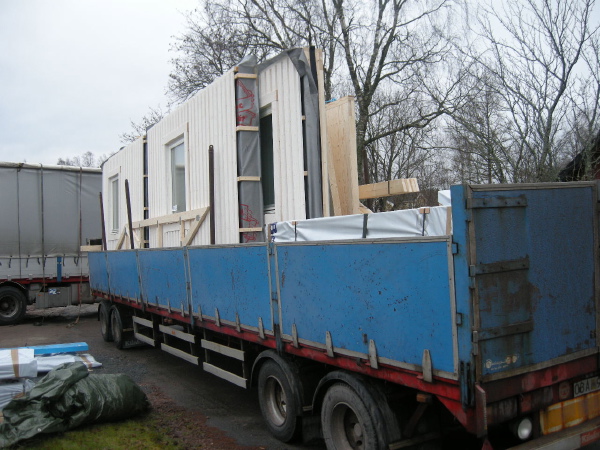 As we've hinted at before the panelized method used by the Swedes requires less shipping than a modular technique. Where modular requires a separate truck/trailer for each module box with panelized a few trucks can usually deliver all the parts. All the wall and floor panels can be loaded on one truck, roof trusses and roofing materials on another. Its a denser method of transport compared to the hollow box of modular construction. Remember, Ikea ships their goods flat-packed because it avoids shipping air!
As we've hinted at before the panelized method used by the Swedes requires less shipping than a modular technique. Where modular requires a separate truck/trailer for each module box with panelized a few trucks can usually deliver all the parts. All the wall and floor panels can be loaded on one truck, roof trusses and roofing materials on another. Its a denser method of transport compared to the hollow box of modular construction. Remember, Ikea ships their goods flat-packed because it avoids shipping air!
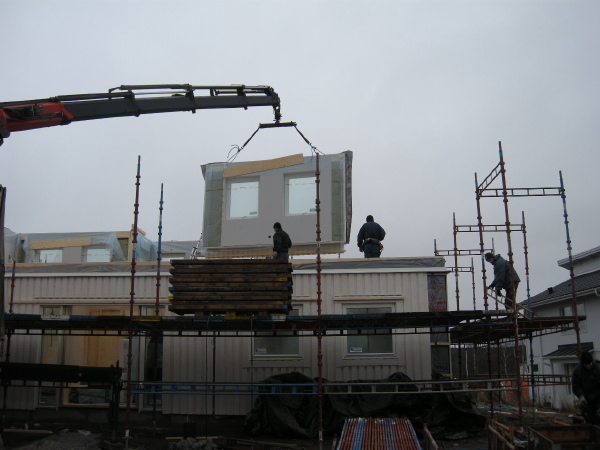 The parts arrive at the site and are craned into place, carpenter fastening the wall panels as they are off-loaded. This is important! They are not stacking them on site to be handled again when they are installed. The come off the truck and into their final resting place in one step. When the ground floor walls are up, then the drywall for the ceilings and wall patches is placed on the floor before the second floor framing goes on. The drywall is delivered with the rest of the panels from the factory, so there is no separate order of materials, and no unloading and carrying of drywall into the house. They leverage the crane for this. Here is a time lapse installation video made by Scott. As you will see the entire house goes up in one day.
Another common technique is the crane enabled delivery truck. This is a flat bed deliver truck which includes a relatively small crane for unloading the panels. We've seen similar equipment in the US. Often lumber yards will have a small lift arm on a flat bed truck for lifting drywall or lumber to a convenient spot on a construction site. Scale that up and you have the Swedish house delivery truck. Often the controls are wireless allowing the operator to get a better view of the load and place it with more ease. These trucks are commonly owned by the factory, which if you remember from earlier posts owns the entire process at the site. So unlike a lumber delivery truck in the US, the truck is not running to the next delivery. It can remain on site and assist with the remaining lifting work - this may mean spending a day at the site, vs unloading in an hour or two and disappearing. This can mean a lot to the speed of construction overall, and it is certainly convenient for delivery and assembly to be unified. Otherwise the builder must have his own equipment on site to handle the panels after delivery. That all adds extra steps which erodes the efficiency of the process.
The parts arrive at the site and are craned into place, carpenter fastening the wall panels as they are off-loaded. This is important! They are not stacking them on site to be handled again when they are installed. The come off the truck and into their final resting place in one step. When the ground floor walls are up, then the drywall for the ceilings and wall patches is placed on the floor before the second floor framing goes on. The drywall is delivered with the rest of the panels from the factory, so there is no separate order of materials, and no unloading and carrying of drywall into the house. They leverage the crane for this. Here is a time lapse installation video made by Scott. As you will see the entire house goes up in one day.
Another common technique is the crane enabled delivery truck. This is a flat bed deliver truck which includes a relatively small crane for unloading the panels. We've seen similar equipment in the US. Often lumber yards will have a small lift arm on a flat bed truck for lifting drywall or lumber to a convenient spot on a construction site. Scale that up and you have the Swedish house delivery truck. Often the controls are wireless allowing the operator to get a better view of the load and place it with more ease. These trucks are commonly owned by the factory, which if you remember from earlier posts owns the entire process at the site. So unlike a lumber delivery truck in the US, the truck is not running to the next delivery. It can remain on site and assist with the remaining lifting work - this may mean spending a day at the site, vs unloading in an hour or two and disappearing. This can mean a lot to the speed of construction overall, and it is certainly convenient for delivery and assembly to be unified. Otherwise the builder must have his own equipment on site to handle the panels after delivery. That all adds extra steps which erodes the efficiency of the process.
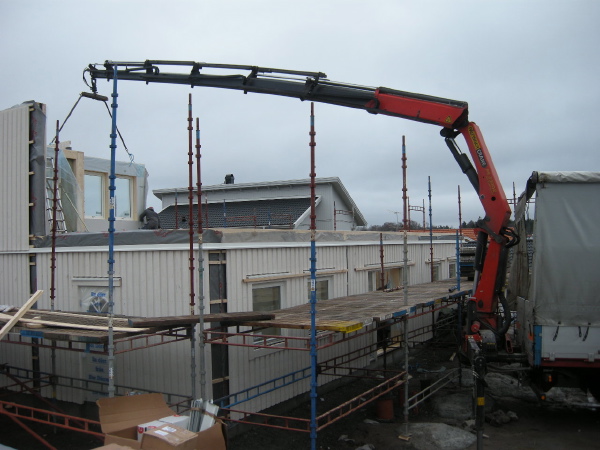
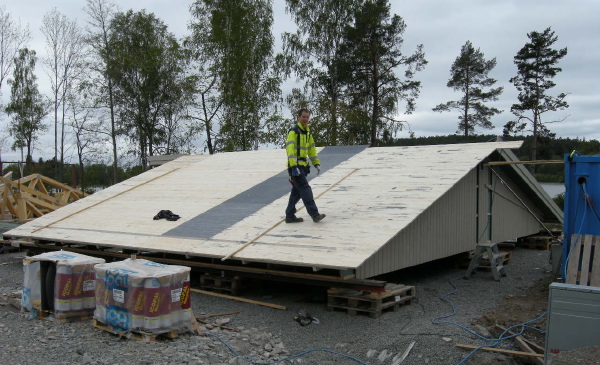 While the house walls are going in on another part of the site the roof will be assembled. The trusses come off the truck and are placed onto a steel jig which has been previously set up to match the top plates of the walls. Roof sheathing goes on, pre-sided end panels go on, and the roof is shingled. This all happens just a few feet above the ground instead of an entire story up. This makes it easier for the workers to get on and off the roof, and carrying materials up is also much easier. From here the roof assembly is craned to the flat bed, carried over to the house, and craned in place.
While the house walls are going in on another part of the site the roof will be assembled. The trusses come off the truck and are placed onto a steel jig which has been previously set up to match the top plates of the walls. Roof sheathing goes on, pre-sided end panels go on, and the roof is shingled. This all happens just a few feet above the ground instead of an entire story up. This makes it easier for the workers to get on and off the roof, and carrying materials up is also much easier. From here the roof assembly is craned to the flat bed, carried over to the house, and craned in place.
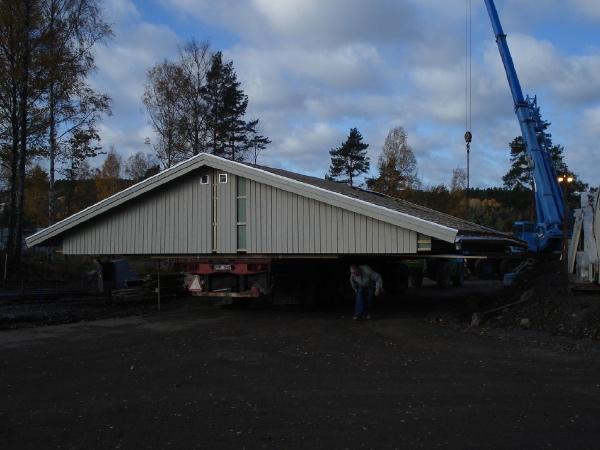 It all happens very quickly, and everything that has gone before was designed to make this field install as fast and as systematic as possible. Remember this is not a curiosity there. This method has completely replaced the site based construction we do here in the US. This is the way the commercial house builders work in Sweden.
It all happens very quickly, and everything that has gone before was designed to make this field install as fast and as systematic as possible. Remember this is not a curiosity there. This method has completely replaced the site based construction we do here in the US. This is the way the commercial house builders work in Sweden.
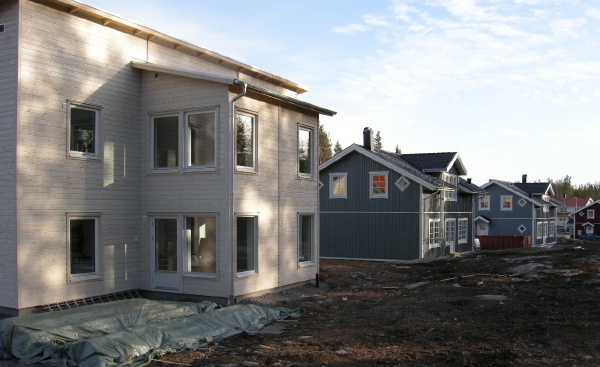 Now that the house is together what is left to do? The joints between panels must be finished and sealed on the outside, and drywalled on the inside. Ceiling drywall must be installed, and wires pulled through the conduits. Connections must be made for plumbing and electrical services, and the HVAC system connections as well. Windows and hardware must be adjusted, and the house made clean for the buyer. Buyers often add sweat equity to finish houses. Painting is common. Floor finishes sometimes as well. Plumbing fixtures as explained before are often installed like appliances after the fact.
One more entry to wrap up the series - we'll look at a range of Swedish house vendors.
Thanks to Scott for photos and video.
Previously:
Letters from Sweden - plumbing the prefab
Letters from Sweden - wiring zen
Letters from Sweden - a windows tale
Letters from Sweden - panel building in Sweden vs the USA
Letters from Sweden - Europe is different, Sweden is not, sort of..
Letters from Sweden - land of modern, land of prefab
Letters from Sweden - conversations with an expatriate builder
Now that the house is together what is left to do? The joints between panels must be finished and sealed on the outside, and drywalled on the inside. Ceiling drywall must be installed, and wires pulled through the conduits. Connections must be made for plumbing and electrical services, and the HVAC system connections as well. Windows and hardware must be adjusted, and the house made clean for the buyer. Buyers often add sweat equity to finish houses. Painting is common. Floor finishes sometimes as well. Plumbing fixtures as explained before are often installed like appliances after the fact.
One more entry to wrap up the series - we'll look at a range of Swedish house vendors.
Thanks to Scott for photos and video.
Previously:
Letters from Sweden - plumbing the prefab
Letters from Sweden - wiring zen
Letters from Sweden - a windows tale
Letters from Sweden - panel building in Sweden vs the USA
Letters from Sweden - Europe is different, Sweden is not, sort of..
Letters from Sweden - land of modern, land of prefab
Letters from Sweden - conversations with an expatriate builder
Technorati Tags: modern design, modern house, prefab house




No comments:
Post a Comment